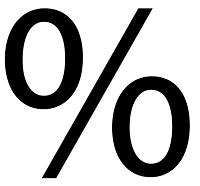What is 003 as a Percentage?We all are very well aware of the word percentage. We all might have encountered this word in our school and college life because the result is always presented as a percentage; the percentage is a ratio or a number that is always expressed in a fraction of a hundred. It is denoted by a unique symbol "%," and "pc" is its abbreviated form; moreover, it is a dimensionless measuring quantity with no unit. Examples of How to Calculate PercentagesFor calculating percentages, we always divide the given number or the numeric value by a hundred, and then multiply the result by 100, because it is a fixed number accepted globally to calculate the percentage of a given number. Let us take the example to calculate the percentage of a given numeric value 003. 
To calculate the percentage, we have to follow the following steps:
Let us take a few more examples of calculating percentages; if we are given a numeric value of 004, then the steps for calculating it are very simple, like before.
If we have to calculate the 25 in percentage form, its steps will be as simple as before.
Now, let us take the example of finding the percentage of 65
The percentage is a common term used in the business sector for calculating profit, loss, gross margin, EBITA, Debt, revenue, equity, and company shares. All these calculations are made in percentages because it is very easy to calculate or maintain the respective company's records. Its usage is not only restricted to the business sectors but also in the research and development field. Scientists keep their records in the form of percentages; for example, The chances for an experiment's success or failure, its record is maintained in percentage form. ConclusionThe percentage is a mathematical quantity unit less, and dimension less is denoted using the symbol (%). The concept of percentage is widely used in almost every sector to maintain records because it makes them easy to understand. This concept of percentage has been taught to the students in the schools since their sixth standard; this depicts its importance and easiness. |
 For Videos Join Our Youtube Channel: Join Now
For Videos Join Our Youtube Channel: Join Now
Feedback
- Send your Feedback to [email protected]
Help Others, Please Share










